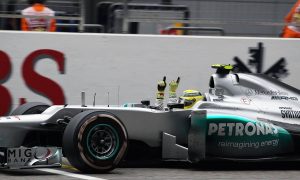
©XPB Images
COMMON FRAMEWORK
Even if bigger teams have more engineers, Green believes the mandated restrictions in terms of windtunnel (60 hours a week) and CFD (25 teraflops) usage create a level-playing field.
“They may have bigger teams, but the way that the rules are written with respect to development within the aero department, the restrictive testing that we work to, is the same for everybody,” he had told F1i’s Eric Silbermann last winter.
“Ferrari might have twice as many people working on it but they’ve got the same amount of testing as we’ve got so it is about being smart, because the richer teams can’t do twice the amount of testing in the tunnel and twice the amount of CFD. You can’t do that. You’ve got to split it. You’ve got a pot of testing and you’ve got to allocate it. We’ve got exactly the same-sized pot as Ferrari and Mercedes.”
Green is not overly worried, at least in his public statements, by the fact that top teams can afford to have a specific working group on the following year’s car. With 2017 set to feature radical regulation changes, it will be interesting to see whether Force India nails F1’s latest rules revolution and can further rise through the ranks to emerge as a top-three team, like Sergio Perez and deputy team principal Bob Fernley have already suggested.

©XPB Images
HAVING A SAY IN RULE MAKING
Drafting a new set of rules hardly is a walk in the park. F1's Strategy Group, which includes the FIA, FOM, five top teams along with the sixth best-ranked team (i.e. Force India), might have the final say but it is up to the technical directors to come up with ideas and proposals based on the initial blueprint they have been given.
“The work of the working group is generally based on a directive; which was: ‘Make the cars much faster and look different’. The teams go away and come up with ideas of how they can do that. Each team has their own ideas, the FIA has its own ideas as well. We discuss each teams ideas, the pros and cons of each one, and we pick one concept that we analyse more in detail to see it would deliver.
“It is a complex and long process, partly because we have to agree, but partly also because it is not just decided between us. For example, we have to involve the people from the tyre manufacturer. Because we make changes to the car, they have to make changes to the tyre... which in turn make new changes to the car.
“We make a proposal: ‘This is the actual downforce of the car’, that we give to Pirelli. Pirelli then look at the tyre and say: ‘This is the size of the tyre we need.’ We put that tyre into the model, and things evolve again, we have to go back to Pirelli saying: ‘This is the new number’. It’s not a short process!”
What will be the state of play in 2017? “Too much willpower is required to achieve enough,” once said French philosopher Gaston Bachelard. Green knows the gap that can exist between a project on paper and the final product, even more so when the deadlines have been tight. But while money can certainly buy tenths, it is not enough to be competitive and Force India is the prime example of this.

©XPB Images






